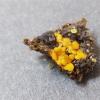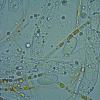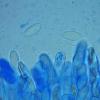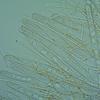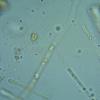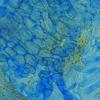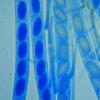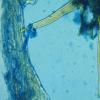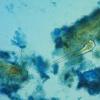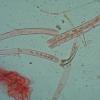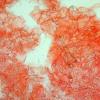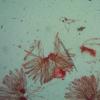
30-08-2011 23:22
 Alex Akulov
Alex Akulov
Dear FriendsOn the deer dung I found very abundant

27-08-2011 15:59
 Cacialli Gabriele
Cacialli Gabriele
Chers amis du Forum,je cherche des récoltes de ho

28-08-2011 10:17
Bonjour à tous, De retour de vacances.Je suis bie

25-08-2011 15:57
 Nicolas VAN VOOREN
Nicolas VAN VOOREN
Bonjour / Hello.Voici un Helotiale qui me pose pro

26-08-2011 23:36
 Peter Welt
Peter Welt
I do not want to overuse, but I still need two art

25-08-2011 18:11
 Yannick Mourgues
Yannick Mourgues
Bonjour.J'ai besoin d'aid epour pouvoir identifier
These discs (max.diameter 1 mm) were found on excrements of Galloway cattle. No hairs on margin or flanks. Spores showed no ornamentation in cotton blue / lactic acid. Free spores mounted in tap water measured 15.0-18.0 x 7.4-8.9 µm. Paraphyses with yellow guttuli and maximum width at the top of 5 µm. Textura of the excipulum consisting of large more or less globose to angular cells.
Could this be Cheilymenia granulata var. elaphorum?
Jan
Unfortunately, I don't have the 2005 monograph, but do have access to the Mycotaxon 38, 1990 paper of Moravec. In that paper Moravec describes the hairs of C. theleboloides as: "although the latter possesses not only hyaline hyphoid hairs with a bulbous base, but also yellowish acuminate hairs with "germs" of roots. The latter consist usually of a bifurcate base of bulbous "primitive germs of roots". However, apothecia of many collections of C. theleboloides possess only hyphoid hairs and lack the acuminate yellowish hairs, or these hairs occur very rarely."
I've have searched the material once more and found two hairs of about 60 µm and similar to the ones already found, and one longer hairlike structure of about 300 µm (see pictures).
I agree with you that the illustrations on p. 463 of Moravec's paper suggest that the hairs should be septate and have a furcate base. These aspects are not visible in the hairs I've found. Could it be that the hairs do not belong to the specimen found? Or are there other options for the combination of characteristics of this specimen?
Kind regards,
Jan
the hair do not belong in my opinion to the mushroom, likely of vegetable origin.
It would be fine, if you could send me the monograph! So, you still think C. theleboloides is the best option for this mushroom?
Kind regards,
Jan

